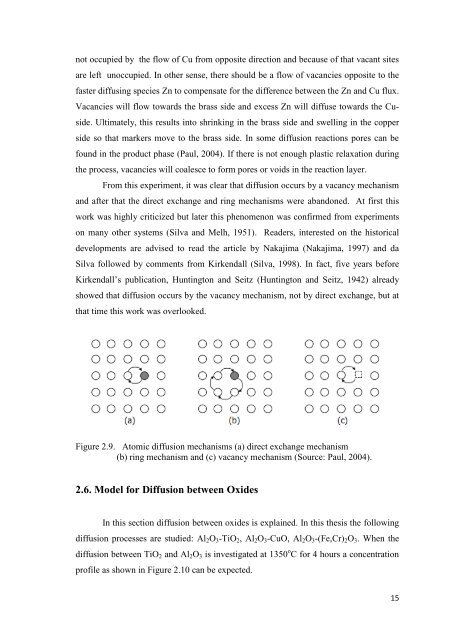use of metal templates for microcavity formation in alumina
use of metal templates for microcavity formation in alumina
use of metal templates for microcavity formation in alumina
You also want an ePaper? Increase the reach of your titles
YUMPU automatically turns print PDFs into web optimized ePapers that Google loves.
not occupied by the flow <strong>of</strong> Cu from opposite direction and beca<strong>use</strong> <strong>of</strong> that vacant sites<br />
are left unoccupied. In other sense, there should be a flow <strong>of</strong> vacancies opposite to the<br />
faster diffus<strong>in</strong>g species Zn to compensate <strong>for</strong> the difference between the Zn and Cu flux.<br />
Vacancies will flow towards the brass side and excess Zn will diff<strong>use</strong> towards the Cu-<br />
side. Ultimately, this results <strong>in</strong>to shr<strong>in</strong>k<strong>in</strong>g <strong>in</strong> the brass side and swell<strong>in</strong>g <strong>in</strong> the copper<br />
side so that markers move to the brass side. In some diffusion reactions pores can be<br />
found <strong>in</strong> the product phase (Paul, 2004). If there is not enough plastic relaxation dur<strong>in</strong>g<br />
the process, vacancies will coalesce to <strong>for</strong>m pores or voids <strong>in</strong> the reaction layer.<br />
From this experiment, it was clear that diffusion occurs by a vacancy mechanism<br />
and after that the direct exchange and r<strong>in</strong>g mechanisms were abandoned. At first this<br />
work was highly criticized but later this phenomenon was confirmed from experiments<br />
on many other systems (Silva and Melh, 1951). Readers, <strong>in</strong>terested on the historical<br />
developments are advised to read the article by Nakajima (Nakajima, 1997) and da<br />
Silva followed by comments from Kirkendall (Silva, 1998). In fact, five years be<strong>for</strong>e<br />
Kirkendall’s publication, Hunt<strong>in</strong>gton and Seitz (Hunt<strong>in</strong>gton and Seitz, 1942) already<br />
showed that diffusion occurs by the vacancy mechanism, not by direct exchange, but at<br />
that time this work was overlooked.<br />
Figure 2.9. Atomic diffusion mechanisms (a) direct exchange mechanism<br />
(b) r<strong>in</strong>g mechanism and (c) vacancy mechanism (Source: Paul, 2004).<br />
2.6. Model <strong>for</strong> Diffusion between Oxides<br />
In this section diffusion between oxides is expla<strong>in</strong>ed. In this thesis the follow<strong>in</strong>g<br />
diffusion processes are studied: Al2O3-TiO2, Al2O3-CuO, Al2O3-(Fe,Cr)2O3. When the<br />
diffusion between TiO2 and Al2O3 is <strong>in</strong>vestigated at 1350 o C <strong>for</strong> 4 hours a concentration<br />
pr<strong>of</strong>ile as shown <strong>in</strong> Figure 2.10 can be expected.<br />
15

















